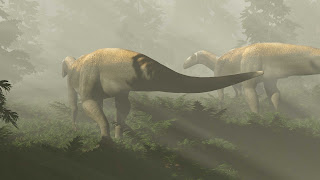 |
| A life-reconstruction of herbivorous dinosaurs based on 220-million-year-old fossil footprints from Ipswich, Queensland, Australia.Image credit: Anthony Romilio. |
 |
| The dinosaur footprint is on display at the Queensland Museum, Brisbane. |
University of Queensland paleontologist Dr Anthony Romilio recently led an international team to re-analyze the footprints, dated to the latter part of the Triassic Period, around 220 million-year-ago.
“For years it’s been believed that these tracks were made by a massive predator that was part of the dinosaur family Eubrontes, with legs over two meters tall,” Dr Romilio said.
“This idea caused a sensation decades ago because no other meat-eating dinosaur in the world approached that size during the Triassic period.
“But our research shows the tracks were instead made by a dinosaur from the Evazoum family – vegetarian dinosaurs that were smaller, with legs about 1.4 meters tall and a body length of six meters.”
The research team suspected there was something not-quite-right with the original size estimates and there was a good reason for their doubts.
“Unfortunately, earlier researchers could not directly access the footprint specimen for their study, instead relying on old drawings and photographs that lacked detail,” Dr Romilio said.
The dinosaur fossils were discovered more than half a century ago around 200 meters deep underground at a coal mine, just west of Brisbane.
“It must have been quite a sight for the first miners in the 1960s to see big bird-like footprints jutting down from the ceiling," Dr Romilio said.
Hendrik Klein, co-author and fossil expert from Saurierwelt Paläontologisches Museum in Germany, said the footprints were made on the water-sodden layers of ancient plant debris with the tracks later in-filled by silt and sand.
 |
| A life-reconstruction of the 220 million-year-old dinosaur track-maker from Ipswich, Queensland, Australia to scale with a 1.7-metre-tall person. Image credit: Anthony Romilio. |
"This explains why today they occur in an upside-down position right above our heads,” Mr Klein said.
“After millions of years, the plant material turned into coal which was extracted by the miners to reveal a ceiling of siltstone and sandstone, complete with the natural casts of dinosaur footprints.”
The mine has long since closed, but fortunately, in 1964, geologists and the Queensland Museum mapped the trackway and made plaster casts, now used in current research.
“We made a virtual 3D model of the dinosaur footprint that was emailed to team members across the world to study,” Mr Klein said.
“The more we looked at the footprint and toe impression shapes and proportions, the less they
 |
| Image credit: Anthony Romilio |
resembled tracks made by predatory dinosaurs – this monster dinosaur was definitely a much friendlier plant-eater.
“This is still a significant discovery even if it isn’t a scary Triassic carnivore.
“This is the earliest evidence we have for this type of dinosaur in Australia, marking a 50-million-year gap before the first quadrupedal sauropod fossils known.”
The research is published in Historical Biology, and includes collaborations between Australian, German, and French researchers.
Source/Credit: University of Queensland
scn102121_04
